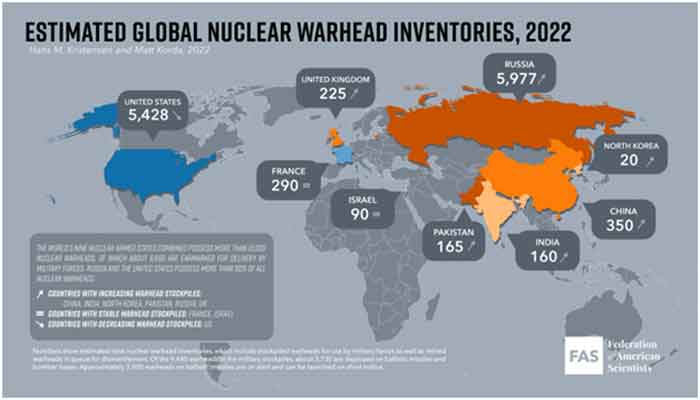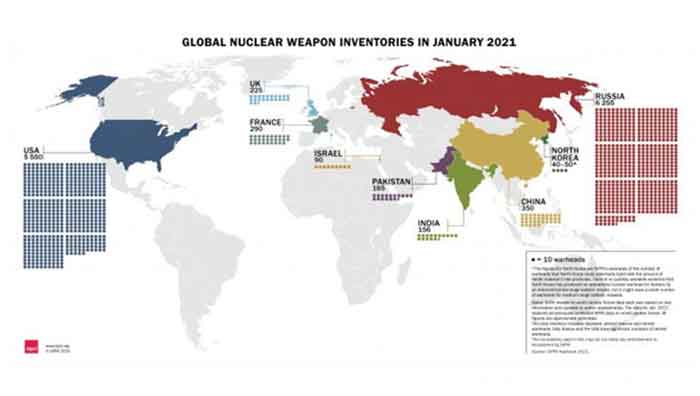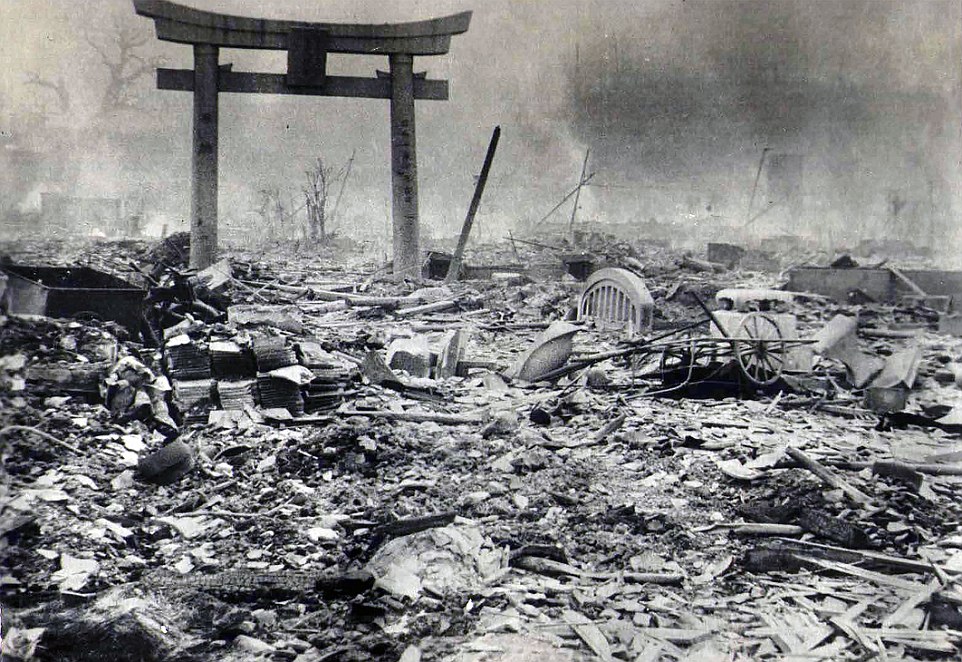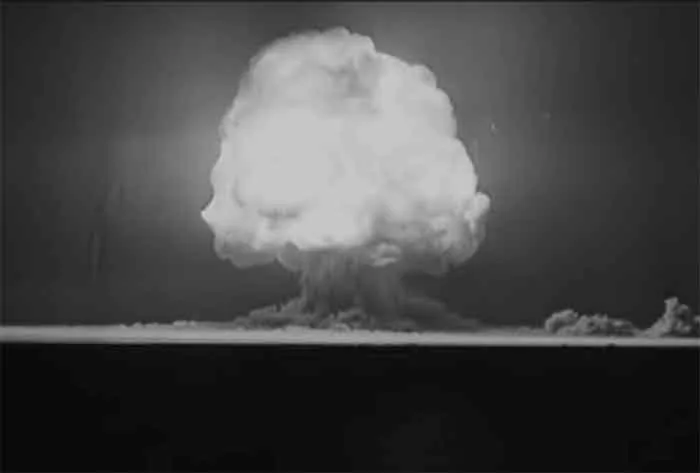

Nuclear powers are actively modernizing and expanding their arsenals amid rising geopolitical tensions, said SIPRI Yearbook 2023, a report by the Stockholm International Peace Research Institute (SIPRI) released on Monday.
Of the total global inventory of an estimated 12 512 warheads in January 2023, about 9576 were in military stockpiles for potential use — 86 more than in January 2022 (see the table below). Of those, an estimated 3844 warheads were deployed with missiles and aircraft, and around 2000 — nearly all of which belonged to Russia or the USA — were kept in a state of high operational alert, meaning that they were fitted to missiles or held at airbases hosting nuclear bombers.
World nuclear forces, January 2023
| MISSING: summary MISSING: current-rows. | |||||||
| Deployed warheadsa | Stored warheadsb | Total stockpilec | Total inventoryd | ||||
| Country | 2023 | 2023 | 2022 | 2023 | 2022 | 2023 | |
| United States | 1 770 | 1 938 | 3 708 | 3 708 | 5 428 | 5 244 | |
| Russia | 1 674 | 2 815 | 4 477 | 4 489 | 5 977 | 5 889 | |
| United Kingdom | 120 | 105 | 225e | 225 | 225 | 225f | |
| France | 280 | 10 | 290 | 290 | 290 | 290 | |
| China | – | 410 | 350 | 410 | 350 | 410 | |
| India | – | 164 | 160 | 164 | 160 | 164 | |
| Pakistan | – | 170 | 165 | 170 | 165 | 170 | |
| North Korea | – | 30 | 25 | 30g | 25 | 30g | |
| Israel | – | 90 | 90 | 90 | 90 | 90 | |
| Total | 3 844 | 5 732 | 9 490 | 9 576 | 12 710 | 12 512 | |
– = nil or a negligible value.
Notes: All estimates are approximate. SIPRI revises its world nuclear forces data each year based on new information and updates to earlier assessments. The data for Jan. 2023 replaces all previously published SIPRI data on world nuclear forces. Countries are ordered by date of first known nuclear test. There is no conclusive open-source evidence that Israel has tested its nuclear weapons. The figures for Russia and the USA do not necessarily correspond to those in their 2010 Treaty on Measures for the Further Reduction and Limitation of Strategic Offensive Arms (New START) declarations because of the treaty’s counting rules.
a ‘Deployed warheads’ refers to warheads placed on missiles or located on bases with operational forces.
b ‘Stored warheads’ refers to stored or reserve warheads that would require some preparation (e.g. transport and loading on to launchers) before they could be deployed.
c ‘Total stockpile’ refers to warheads that are intended for use by the armed forces.
d ‘Total inventory’ includes both stockpiled warheads and retired warheads awaiting dismantlement.
e SIPRI previously estimated that the UK had about 45 retired warheads awaiting dismantlement; however, SIPRI’s assessment as of Jan. 2023 is that these warheads are likely to be reconstituted to become part of the UK’s growing stockpile over the coming years and the stockpile number remained at 225 in Jan. 2022.
f The British government declared in 2010 that its nuclear weapon inventory would not exceed 225 warheads. It is estimated here that the inventory remained at that number in Jan. 2023. A planned reduction to an inventory of 180 warheads by the mid 2020s was ended by a government review published in 2021. The review introduced a new ceiling of 260 warheads.
g Information about the status and capability of North Korea’s nuclear arsenal comes with significant uncertainty. North Korea might have produced enough fissile material to build 50–70 nuclear warheads; however, it is likely that it has assembled fewer warheads, perhaps around 30.
Table: SIPRI © Source: SIPRI Yearbook 2023.
The SIPRI analysts warn the world is “drifting into one of the most dangerous periods in human history”.
The SIPRI estimated that as of January 2023, Russia, the U.S., the UK, France, China, India, Pakistan, North Korea and Israel had a total of 12,512 warheads, with 9,576 stored in military stockpiles for potential use – an increase of 86 from one year previously.
The report also claimed that as of January, Russia and the U.S. – which between them possess almost 90% of the world’s nuclear weapons – had 1,674 and 1,770 deployed warheads respectively. Last year, Russia had approximately 1,588 warheads while the US had 1,744.
The SIPRI noted that “the sizes of their respective nuclear arsenals seem to have remained relatively stable in 2022, although transparency regarding nuclear forces declined in both countries” following the outbreak of hostilities in Ukraine.
Over the course of the year, China’s nuclear arsenal grew from 350 warheads to 410, SIPRI estimated, adding that by the end of the decade China “could potentially have at least as many intercontinental ballistic missiles as either the USA or Russia.”
Elsewhere, the UK is not thought to have increased its arsenal in 2022, although its number of warheads is expected to grow in the years to come.
France has continued its nuclear development program, while India and Pakistan appear to be expanding their nuclear arsenals, the report said.
North Korea is said to be prioritizing its nuclear program and is estimated to have assembled some 30 warheads. Israel, which has not publicly admitted to possessing nuclear weapons, is also believed to be modernizing its nuclear arsenal, SIPRI added.
The SIPRI also pointed to the erosion of global arms control architecture amid the Ukraine conflict, noting Washington’s decision to freeze strategic stability dialogue with Russia and Moscow’s suspension of the 2010 New START Treaty, which places limits on U.S. and Russian nuclear arsenals.
Russian President Vladimir Putin announced the move in February, pointing to the refusal of Western powers to permit inspections of their nuclear facilities. He confirmed that Moscow would continue to abide by the deal’s limits on deployed warheads.
A SIPRI news said:
‘Most of the nuclear-armed states are hardening their rhetoric about the importance of nuclear weapons, and some are even issuing explicit or implicit threats about potentially using them,’ said Matt Korda, Associate Researcher with SIPRI’s Weapons of Mass Destruction Programme and Senior Research Associate with the FAS Nuclear Information Project. ‘This elevated nuclear competition has dramatically increased the risk that nuclear weapons might be used in anger for the first time since World War II.’
‘With billion-dollar programmes to modernize, and in some cases expand, nuclear arsenals, the five nuclear weapon states recognized by the Nuclear Non-Proliferation Treaty seem to be moving further and further from their commitment to disarmament under the treaty,’ said Wilfred Wan, Director of SIPRI’s Weapons of Mass Destruction Programme.
It said:
The USA and the UK both declined to release information to the public concerning their nuclear forces in 2022, which they had done in previous years.
‘In this period of high geopolitical tension and mistrust, with communication channels between nuclear-armed rivals closed or barely functioning, the risks of miscalculation, misunderstanding or accident are unacceptably high,’ says Dan Smith, SIPRI Director. ‘There is an urgent need to restore nuclear diplomacy and strengthen international controls on nuclear arms.’
Global security and stability in increasing peril
The 54th edition of the SIPRI Yearbook reveals the continuing deterioration of global security over the past year. The impacts of the war in Ukraine are visible in almost every aspect of the issues connected to armaments, disarmament and international security examined in the Yearbook. Nevertheless, it was far from being the only major conflict being waged in 2022.
‘We are drifting into one of the most dangerous periods in human history,’ says Dan Smith, SIPRI Director. ‘It is imperative that the world’s governments find ways to cooperate in order to calm geopolitical tensions, slow arms races and deal with the worsening consequences of environmental breakdown and rising world hunger.’















































